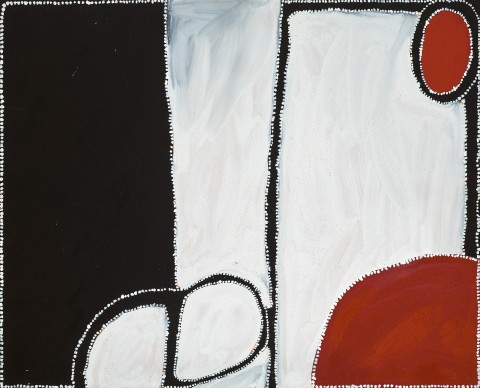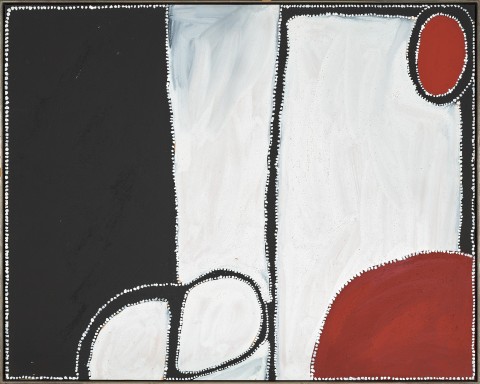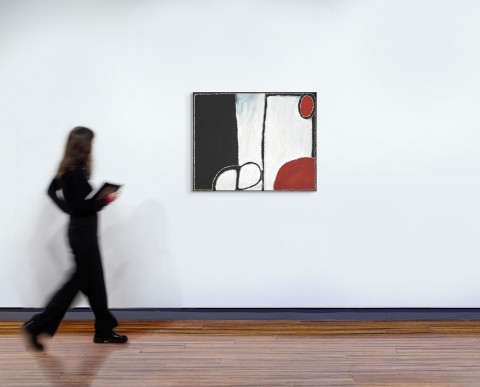(c.1922 - 2007)
Paddy Nyunkuny Bedford
Winperrji - Police rock hole, 2004
natural earth pigments and synthetic binder on board
Jirrawun Arts, Kununurra, Western Australia
Laverty collection, Melbourne, acquired from the above in 2004
Michael, L. (ed.), Paddy Bedford, Museum of Contemporary Art, Sydney, 2006, p. 161 (illus.)
Beyond Sacred: Australian Aboriginal Art - The collection of Colin and Elizabeth Laverty, Edition II,
Kleimeyer Industries, Melbourne, 2011, p. 250 (illus.)
Paddy Nyunkuny Bedford painted with a deep sense of cultural responsibility, with the professional practice of this respected senior Gija artist and lawman focused upon stories from the countries of his mother, father, and uncle. He was major custodian of three significant sites – Garnanganyjen (Emu), Birnkirrbal (Bush Turkey) and Ngayilanji (White Cockatoo) – and his idiosyncratic depictions of these sites bestows a visual representation of Indigenous cultural memory that contributes to a growing body of work promoting the decolonisation of Australian history.
Catalogued as painting PB CB 3-2004.22 in Bedford's chronological index of works, this painting on custom board was executed in 2004, and represents the country of Winperrji (Police Rock Hole). Also known as Police Camp, this site is found between Warmun and Bedford Downs in his mother's country, approximately 15 kilometers to the west of Bedford Downs homestead. Located on foal creek, and home to a large deep permanent waterhole, it is the dreaming place of Jarlangarnany (the plains kangaroo), and an important camping site for the Gija prior to European settlement. Winperrji was also used as a camping spot for police in the early twentieth century when travelling between Halls Creek and the Port of Wyndham.
Winperrji – Police rock hole, 2004 exemplifies Bedford's move away from the more familiar style of the earlier east Kimberley painters to create his own representations of country. With the introduction of a contrasting black and white ground, his use of colour has evolved from a purely ochre palette. The composition often includes the intrusion of solid forms of varied colour and the surface may be softened by washes of pink or blue grey in a wet-on-wet process that first appeared on his canvases in 2003, with the artist employing a mixture of white and coloured pigment suspended in an acrylic medium to add a unique depth to the painting surface.
From the time Bedford first painted in 1998, his stories on board and canvas were executed with an authority and confidence that reflected his importance as a traditional elder, embodying the eternal presence of the Dreaming or Ngarranggarni in his native Gija language. Steeped in traditional lore, he drew on a seemingly endless source of knowledge related to significant sites. His paintings of these sites – combined with the physical experience of mountain ranges, rivers, roads, bridges and country traversed while mustering and living typical station life – unite as a record of memories, of place, landscape and personal experiences that correspond with stories of the Ngarranggarrni.
The importance of painting for Paddy Bedford was multi-layered – an expression of country and cultural memory, as well as a claim to identity and consequently an assertion of ownership to the land itself. As Michael Dolk notes, his painting suggests a physical and tactile relation to land: ‘To behold painting is to hold country and to remain beholden to its ancestral tradition.’1
1. Dolk, M., ‘Are We Strangers in this Place?’, in Storer, R., Paddy Bedford, Museum of Contemporary Art, Sydney, 2006, p. 20
CRISPIN GUTTERIDGE


